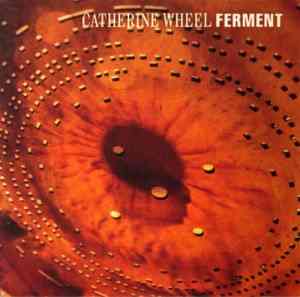1) Texture; 2) I Want To Touch
You; 3) Black Metallic; 4) Indigo Is Blue; 5) She's My Friend; 6) Shallow; 7)
Ferment; 8) Tumbledown; 9) Bill And Ben; 10) Salt; 11) Balloon.
Here's an odd coincidence for you: Rob
Dickinson, one of the two primary founding members of Catherine Wheel, was the
cousin of Bruce Dickinson, lead vocalist of Iron Maiden. See that? Iron maiden?
Catherine wheel? What's up with these British bands and medieval torture
devices? (Allegedly, the band did not call itself that because of the torture
device itself, but rather because of the spinning firework named after it — yet
that does not destroy the coincidence anyway).
Granted, the music of Catherine Wheel will only
sound torturous to people with an inborn aversion to the wall-of-sound
principle. Raised and nurtured on the shoegazing scene, Dickinson and the
band's second guitarist Brian Futter seem to have subscribed to the My Bloody
Valentine and the Nirvana fanclub at
the same time — their sound is a mixture of shoegazing hypnotism and grungey
harshness, which, in the wrong hands, could seem like a suicidal recipe for
boring alt-rock sludge. Fortunately, on their debut album they also have the
good sense to combine these influences with decent pop hooks and a certain
spiritual lightness that makes the songs really touching when they're good, and
tolerable even when they're boring.
The two biggest singles from here are also the
best tracks. ʽI Want To Touch Youʼ, with a Stone Roses / Madchester echo, is a
perfect introduction to the band's early sound — a fluently spinning, sparkling
lead guitar part floating over the distorted rhythm vamp; clever use of the
wah-wah pedal for extra psychedelic effect; Dickinson's «ethereal» vocals and
their repetitive hookline that somehow agrees so well with the hazy,
multi-layered arrangement... it's as if the singer is truly prevented from the temptation of
touching you because there's a magical forcefield between the subject and
object of touching. Yes, it's a very derivative song (if you really wanted to
offend, you could easily call it a Stone Roses rip-off), but unlike many other
derivative songs, this one is totally cool in its atmospheric flow.
Then there's the much longer and more complex
ʽBlack Metallicʼ, where we turn from the tactile temptation to surface analysis
— apparently, "your skin is black metallic", whatever that might mean
(not sure it's a compliment!), and to drive that message home, they make use of
slow tempo, gradual build-up, stormy solos, loud-to-quiet-and-back-to-loud
dynamics, and whatever it takes, essentially, to share an epic feel. I don't
know why it works, really, but it does. The lyrics suggest a reading of the
«cruel beauty» variety, and the music reflects a sense of cruelness and beauty
at the same time — with an additional tinge of sadness (which, I guess, is
precisely the kind of thing that happens when you mix cruelness with beauty)
coming from Dickinson's vocals. Apparently, the public felt the same, because
the song even managed to chart (on the «Modern Rock» chart only) in the US,
despite the long-windedness and the ambient feel.
That's pretty much all that needs to be said
about the record's meat-'n'-potato layer: repetitive, helium-fueled vocal hooks
over a bedrock of shoegrunging guitar textures (hey, even the very first song
here is simply called ʽTextureʼ, and its motto? "I need more texture!..
You need to give me more texture!" Come on, Rob, you're nothing but texture already!). Sometimes they
speed up and become a little funkier and more Madchester-ish (ʽShe's My
Friendʼ), but there is never really any essential deviation from the formula,
and all the songs set the same mood. The good news is, they are willing to
really work on the tunes, and additional listens bring out different riffs and
also make you really appreciate the lead guitar skills of Futter, who seems to
have made Robert Fripp and Robin Guthrie his prime teachers, and although I
couldn't say that he has overcome them on any single point, he is still a
worthy disciple (and his technique is really excellent even when it is heavily masked
by the production — on songs like ʽBill And Benʼ, for instance, he delivers
terrific kaleidoscopic fireworks through the wah-wah pedal).
In fact, Ferment
works as an excellent introduction into the «atmospheric alt-rock» scene of
late Eighties / early Nineties Britain to those who want their shoegazing with a little bit of rocking energy and a little
more song-like shape. Arguably, it is the band's best offering (at least, compared
to the next few records) because after this, they would tip the balance way too much towards the metallic
angle; here, the balance between harshness and romanticism is close to perfect.
Funnily enough, the record that Ferment
reminds me of the most, from my somewhat limited experience, is Blur's Leisure — except that on the latter,
all atmospheric textures were strictly subjugated to the pop hook, whereas on Ferment it is strictly the opposite. I
guess it just goes to show the overall popularity of this type of sound back in
its day, but it was a good sound when the song structures and arrangements
behind it weren't too lazy, and Ferment,
if anything, demonstrates to you all the hidden dynamics and inventiveness
behind the art of sleepy daydreaming — and yes, it's probably taken best in a
hammock during siesta time, but it still gets a thumbs up even if I never had the
chance to listen to it under proper conditions.













